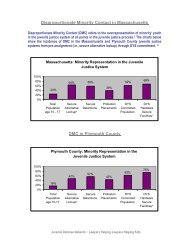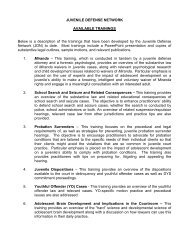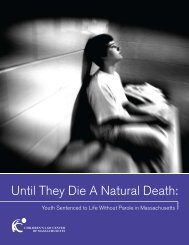States rethink 'adult time for adult crime' - the Youth Advocacy Division
States rethink 'adult time for adult crime' - the Youth Advocacy Division
States rethink 'adult time for adult crime' - the Youth Advocacy Division
Create successful ePaper yourself
Turn your PDF publications into a flip-book with our unique Google optimized e-Paper software.
impulses and should not be held fully accountable “<strong>for</strong> <strong>the</strong> immaturity of <strong>the</strong>ir<br />
neural anatomy.” In his majority decision, Justice Anthony Kennedy declared<br />
that “as any parent knows and as <strong>the</strong> scientific and sociological studies” cited in<br />
<strong>the</strong> briefs “tend to confirm, ‘[a] lack of maturity and an underdeveloped sense of<br />
responsibility are found in youth more often than in <strong>adult</strong>s.’ ” Although Kennedy<br />
did not cite <strong>the</strong> neuroscience evidence specifically, his indirect reference to <strong>the</strong><br />
scientific studies in <strong>the</strong> briefs led some supporters and critics to view <strong>the</strong> decision<br />
as <strong>the</strong> Brown v. Board of Education of neurolaw.<br />
One important question raised by <strong>the</strong> Roper case was <strong>the</strong> question of where to<br />
draw <strong>the</strong> line in considering neuroscience evidence as a legal mitigation or<br />
excuse. Should courts be in <strong>the</strong> business of deciding when to mitigate someone’s<br />
criminal responsibility because his brain functions improperly, whe<strong>the</strong>r because<br />
of age, in-born defects or trauma As we learn more about criminals’ brains, will<br />
we have to redefine our most basic ideas of justice<br />
Two of <strong>the</strong> most ardent supporters of <strong>the</strong> claim that neuroscience requires <strong>the</strong><br />
redefinition of guilt and punishment are Joshua D. Greene, an assistant professor<br />
of psychology at Harvard, and Jonathan D. Cohen, a professor of psychology who<br />
directs <strong>the</strong> neuroscience program at Princeton. Greene got Cohen interested in<br />
<strong>the</strong> legal implications of neuroscience, and toge<strong>the</strong>r <strong>the</strong>y conducted a series of<br />
experiments exploring how people’s brains react to moral dilemmas involving life<br />
and death. In particular, <strong>the</strong>y wanted to test people’s responses in <strong>the</strong> f.M.R.I.<br />
scanner to variations of <strong>the</strong> famous trolley problem, which philosophers have<br />
been arguing about <strong>for</strong> decades.<br />
The trolley problem goes something like this: Imagine a train heading toward five<br />
people who are going to die if you don’t do anything. If you hit a switch, <strong>the</strong> train<br />
veers onto a side track and kills ano<strong>the</strong>r person. Most people confronted with this<br />
scenario say it’s O.K. to hit <strong>the</strong> switch. By contrast, imagine that you’re standing<br />
on a footbridge that spans <strong>the</strong> train tracks, and <strong>the</strong> only way you can save <strong>the</strong> five<br />
people is to push an obese man standing next to you off <strong>the</strong> footbridge so that his<br />
body stops <strong>the</strong> train. Under <strong>the</strong>se circumstances, most people say it’s not O.K. to<br />
kill one person to save five.
















